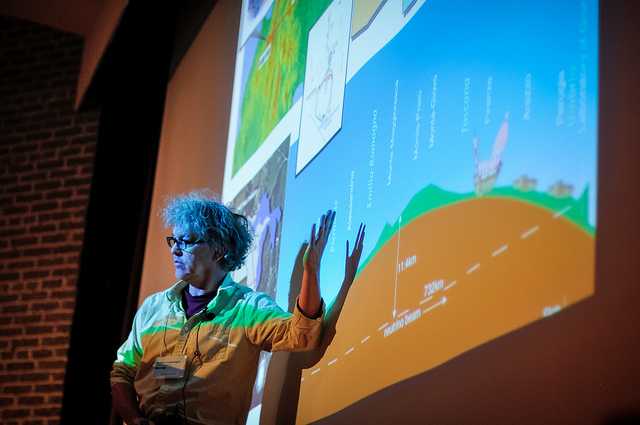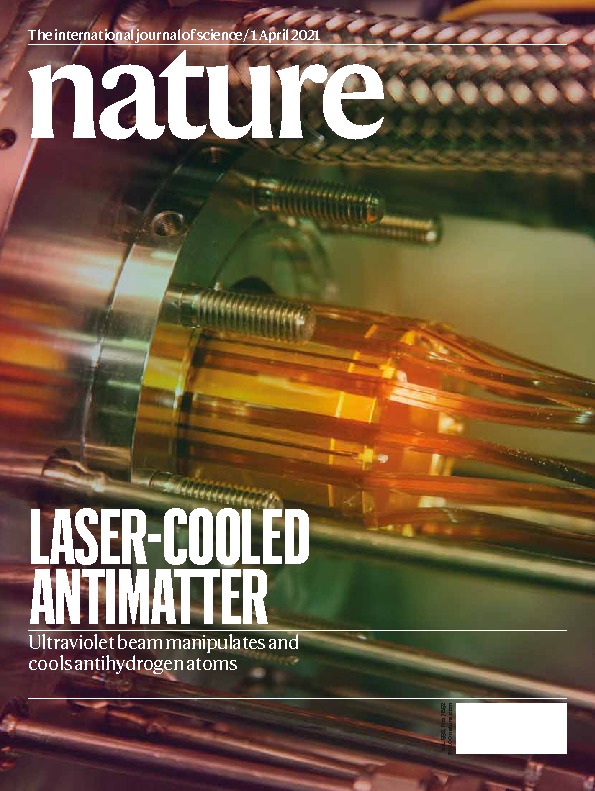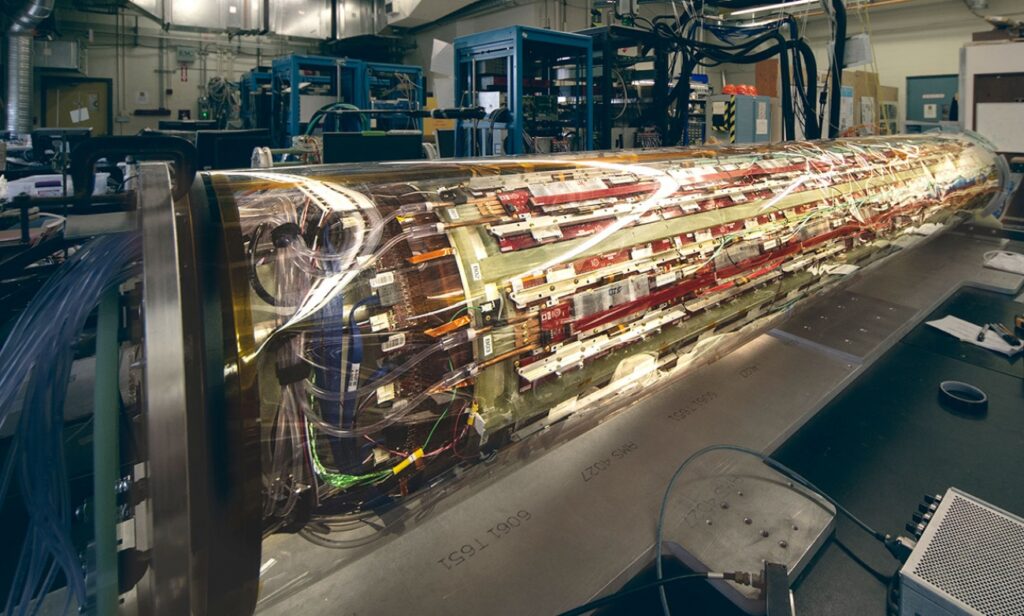
"If I knew what I was doing, it wouldn't be research."
D.M. Winnicott
Presently I Am Concentrating On:
Testing Fundamental Symmetries with Trapped Antihydrogen
A primary reason for making measurements with antimatter is to try to find clues to one of the central mysteries of our time - namely, "Where is all the antimatter?" That is, in the Big Bang, matter and antimatter were created in equal amounts but the universe is now dominated by matter. This is a good thing as matter and antimatter annihilate each other so we wouldn't be around if this wasn't the case. But it still begs the question as to the mechanism that led to the disappearance of the primordial antimatter. You can hear me talk about this on the "Big Questions" Quirks & Quarks show broadcast June 21, 2014 as well as my "the star spot" podcast Where Have All the Antimatter Gone? broadcast on June 15, 2014. A few years ago I also gave a public lecture about this using as a central theme the movie "Angels & Demons" where antimatter is used as bomb (trailer alert: not possible, so relax). By the way, while there isn't a lot of it, it is still true that there is antimatter all around us - even coming from you ... and bananas! A nice discussion of antimatter is given in Ten things you might not know about antimatter (April, 2015) although, come on, admit it, you know at least 5 of them.
The ALPHA (Antihydrogen Laser PHysics Apparatus) experiment ( animation) is done at CERN's Antiproton Decelerator. The AD has been upgraded with a new deceleration ring ELENA which is to come online in 2021 (LS2 Report: waiting for antiprotons... - CERN News, October, 2020). ALPHA managed to produce and hold ("trap") antihydrogen atoms for as long as 1000s (2011), made the first measurment of microwave transitions in antihydrogen (2012), and measured the charge of antihydrogen (2014). The Canadian group on ALPHA was awarded the 2013 NSERC Polanyi Prize.
Not to toot our own horn or anything but in 2010 ALPHA along with another AD experiment called ASACUSA were named the Physics World Breakthrough of the Year. We were one of the finalists for the 2021 Breakthrough of the Year but ultimately Quantum entanglement of two macroscopic objects is the Physics World 2021 Breakthrough of the Year. You win some, you lose some.
Spectroscopic Measurements with ALPHA
Spectral lines can be measured with great precision. Comparing the spectral lines of antihydrogen with those of hydrogen allows for one of the most precise tests of the CPT Theorem (a kind of symmetry between matter and antimatter) which requires the lines to be exactly the same. CPT invariance is a fundamental requirement of a quantum field theory and the Standard Model, the theory that describes the interactions of elementary particles, is a quantum field theory. Finding deviations from CPT invariance would have enormous implications for physics and would require a rethink of our mathematical description of nature. A clear, detailed discussion of testing CPT (and gravity, see below) using trapped antihydrogen is given in the 2015 PhD thesis by Andrea Capra.
Here are some recent results:

- Laser cooling of antihydrogen atoms - nature, April 1, 2021
- Antimatter cooled by laser light - nature
- ALPHA cools antimatter using laser light for the first time - CERN press release
Laser-cooled antihydrogen takes ALPHA into new realm - CERN Courier - Canadian University Press Releases
- York University - York researchers part of international effort to cool a sample of antimatter to near absolute zero
- TRIUMF - Canadian-built laser chills antimatter to near absolute zero for first time
- UBC - Canadian-built laser chills antimatter to near absolute zero for first time
- SFU - Research collaboration achieves world's first laser-cooling of antimatter
- University of Calgary - Physics researchers achieve first-ever cooling of antimatter by laser
- University of Victoria - Made-in-Canada laser first in world to trap antimatter
- In the media
- 'Cool' new Canadian-built laser will help scientists probe antimatter mysteries - Quirks & Quarks
- Scientists figure out how to put the brakes on antimatter atoms - CBC
- Scientists Make Big Step Towards Making Antimatter Stand Still - Forbes
- Physicists Learn to Superfreeze Antimatter (Hint: Pew Pew!) - WIRED
- Antimatter atoms can be precisely manipulated and cooled with lasers - New Scientist
- Frozen antimatter could answer physics biggest questions - Inverse
- Scientists Directly Manipulated Antimatter With a Laser In Mind-Blowing First - Motherboard (Vice)
- Researchers achieve world's first manipulation of antimatter by laser - PhysOrg
- Researchers Manipulate Antimatter With Laser for the First Time - The Science Times
- Laser cooling of antimatter particles could rewrite modern physics - The Academic Times
- Physicists Laser-Cool Antimatter to Near Absolute Zero - Gizmodo
- Newly made laser-cooled antimatter could test foundations of modern physics - Science News
- Physicists give antimatter the chills - arsTECHNICA
- Researchers achieve world's first manipulation of antimatter by laser - Gamers Grade!
- Researchers trap, and cool, antimatter with laser for first time - METRO News (UK)
- Where did the antimatter go? - The Express Tribune (Pakistan)
- The original paper by Fujiwara et al. that proposed doing this.
- A proposal for laser cooling antihydrogen atoms - Journal of Physics B 46, January, 2013
- Lasers could chill antihydrogen - physicsworld
- A proposal for laser cooling antihydrogen atoms - Journal of Physics B 46, January, 2013
- Investigation of the fine structure of antihydrogen - nature, February, 2020
- Fundamental symmetry tested using antihydrogen - nature
- Physicists Take Their Closest Look Yet at an Antimatter Atom - Wired
- Physicists Come Closer to Answering Question of Antimatter's Scarcity - Scientific American
- Antimatter looks just like matter - which is a big problem for physics - New Scientist
- ALPHA collaboration at CERN reports first measurements of certain quantum effects in antimatter - CERN
- Observation of the 1S-2P Lyman-alpha transition in antihydrogen - nature, August, 2018
- ALPHA takes antihydrogen to the next level - CERN Courier
- Characterization of the 1S-2S transition in antihydrogen - nature, April, 2018
- Antihydrogen spectroscopy enters precision era - CERN Courier
- Observation of the hyperfine spectrum of antihydrogen - nature, August, 2017
- Illuminating antimatter - CERN Courier
- Antihydrogen gives way to spectroscopic study - Physics Today
- Observation of the 1S-2S transition in trapped antihydrogen - nature, December, 2016
- An improved limit on the charge of antihydrogen from stochastic acceleration - nature, January, 2016
Testing Gravity with ALPHA-g
I am also involved with the efforts to use trapped antihydrogen to test the gravitational interaction between matter and antimatter (so-called "antigravity"). I wrote a little paper in 2012 - "Why We Already Know that Antihydrogen is Almost Certainly NOT Going to Fall "Up"" - where I argued that it is probably not much different from the matter-matter gravitational interaction but there is still wiggle room and, as always, it is an experimental question! As said by Shel Silverstein in his poem "Falling Up"
I tripped on my shoelace
And I fell up -
Up to the roof tops,
Up over the town,
Up past the tree tops,
Up over the mountains,
Up where the colors
Blend into sounds.
But it got me so dizzy
When I looked all around,
I got sick to my stomach
And I threw down.
We designed an optimized experiment (ALPHA-g) to probe this fundamental question. Here are some articles about the status of ALPHA-g prior to our first run in 2022:
- Do opposites attract? ALPHA-g prepares to explore antimatter gravity - March, 2021
- Exploring how antimatter falls - November, 2018
- New antimatter gravity experiments begin at CERN - November, 2018
- New ALPHA-g Detector Poised to Search for Signs of Antigravity - October, 2018
- Prospects for comparison of matter and antimatter gravitation with ALPHA-g - February, 2018
- Does antimatter fall up? - February, 2017
You can watch Timelapse videos of the construction in 2018 of the ALPHA-g apparatus in the ALPHA pit. It's really amazing how the pit got filled up with stuff!
The part of ALPHA-g that I specifically work on is antihydrogen detection using a tracking chamber (a so-called radial Time Projection Chamber or rTPC) and a scintillating cosmic ray veto detector. Here is some information about the rTPC:
- Design of a Radial TPC for Antihydrogen Gravity Measurement with ALPHA-g - September, 2016
- Design of a Radial TPC for Antihydrogen Gravity Measurement with ALPHA-g - June, 2016

Long-baseline Neutrino Experiments using Liquid Argon Time Projection Chambers (LArTPC)
- Neutrino oscillation physics using a large (15 to 50 kton) Liquid Argon Time Projection Chamber. The neutrino source could have been either the off-axis NuMI beam from Fermilab (subsequently using other technology), a future high intensity neutrino beam from Fermilab towards DUSEL (now realized as the DUNE experiment), or a future neutrino facility like a Neutrino Factory. Here is a nice video showing neutrino reconstruction for the NOvA experiment on which I was a collaborator for a while.
- I worked as a Fermilab Associate Scientist on the Neutrinos at the Main Injector (NuMI) project. The review of Fermilab carried out by the U.S. Department of Energy (where I presented the case for NuMI) is reported in the July 18, 1997 issue (note that it includes a rare picture of me on page 5 wearing a suit!) of Ferminews. The December 11, 2014 issue of Fermilab Today had a nice "Physics in a Nutshell" explanation of How to make a neutrino beam. Fermilab TM-2018, "Conceptual Design for the Technical Components of the Neutrino Beam for the Main Injector", is a fairly complete description of the NuMI neutrino program including a detailed description of the physics and technical elements of the neutrino beamline.
- Here is my contribution to educating the public about neutrinos. In this case, I was asked to respond to a question about neutrinos that was emailed to the Fermilab Public Affairs Office.
- It's been confirmed what we already suspected, Physicists Hail Major Breakthrough After Discovering Neutrinos Just Little Italian Neutrons! (July, 2020)
Muon Colliders
- One large advantage of lepton colliders such as the e+e- colliders LEP and SuperKEKB over hadron colliders like the proton-proton collider LHC is that all of the beam energy goes into the primary collision. That is, in a 91 GeV per beam collider like LEP, there is 182 GeV of energy available for new particle production since the collision is a point-particle on point-particle collision. At the LHC, on the other hand, the protons may have a kinetic energy of 7 TeV or so but the proton is not a point-particle and so that energy is shared among the constituents of the proton, the quarks and gluons. The actual point-particle collisions (the so-called "hard collision") are between constituents of the colliding protons and so the energy available for production of new particles is often considerably less than 14 TeV. Why not then just build a 14 TeV center-of-mass energy e+e- collider you ask? The answer is synchrotron radiation, the EM radiation emitted by charged particles when they are accelerated (as happens for a charged particle travelling in a circular path as in a collider). The problem is that for a given kinetic energy and accelerator radius, the power (energy/time) of the emitted radiation is inversely proportional to the 4th power of the mass of the particle being accelerated. Since the proton is around 2000 times as massive as the electron, then amount of synchrotron radiation emitted for an electron is 20004 times greater than for a proton. You can reduce this loss by increasing the radius but it puts a major limit on e+e- colliders and is the reason why LEP basically set the energy limit for circular colliders while the LHC uses the same tunnel but has beams with almost 100 times the energy.
- One could get around this to some extent (i.e., have the advantages of leptonic point-particle collisions but with much less synchrotron radiation loss) if there were a heavier lepton than the electron. Luckily there is - the muon. I have for many years (as in several decades) thought that muon colliders were the way to go. Oddly enough there are quite a number of other crazy souls out there as well as evidenced by this August, 2023 article from Scientific American - Particle Physicists Dream of a Muon Collider. There's also the November, 2021 article from APS News - Muon Colliders Hold a Key to Unraveling New Physics. Ah, to sleep, perchance to dream …
- Another the nice thing is that with a muon collider you also get a Neutrino Factory essentially for free. A Neutrino Factory was historically seen as a precursor to a Muon Collider since you don't need two (colliding) beams but just one. Here's a small sample of the various design reports, etc., over the years:
- Expression of Interest in R & D towards a Neutrino Factory Based on a Storage Ring and a Muon Collider - November, 1999
- From Neutrino Factory to Muon Collider - June, 2010
- The NuMAX Long Baseline Neutrino Factory Concept - May, 2018
- The future prospects of muon colliders and neutrino factories - March, 2019
Past Experimental Collaborations:
- The ZEUS experiment at the HERA accelerator located at the DESY laboratory in Hamburg, Germany, stopped taking data on June 30, 2007. For a history of DESY's change in emphasis from high-energy physics to "photon" physics have a look at Turning the Ship: The Transformation of DESY, 1993–2009. We were part of the team which constructed a new Strawtube Tracker (STT). The device was installed in early 2001 in order to greatly enhance the reach for high Q2 physics as well as heavy flavour physics.
- BTeV - the hadron collider CP Violation experiment at Fermilab. BTeV was summarily terminated by the U.S. Department of Energy on February 7, 2005 (in a press conference no less). See the Response from BTeV. It was all very sad.
- The CLEO experiment at CESR, the Cornell Electron Storage Ring.
- The BaBar Silicon Vertex Detector
- The Silcon Vertex Detector for the ALEPH experiment at the LEP collider at CERN.
- The Tagged Photon Spectrometer Collaboration (E691) at Fermilab.
- There is a rather funny article from the February, 1987, Chicago Tribune discussing what life was like for a young male at Fermilab at this time. (It has since improved .... a bit.)
- A (then young) theoretical physicist mentioned in the article, Marcello Gleiser, won the 2019 Templeton Prize
- There is a rather funny article from the February, 1987, Chicago Tribune discussing what life was like for a young male at Fermilab at this time. (It has since improved .... a bit.)
